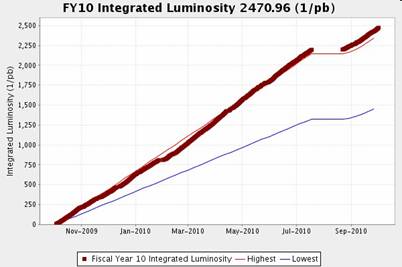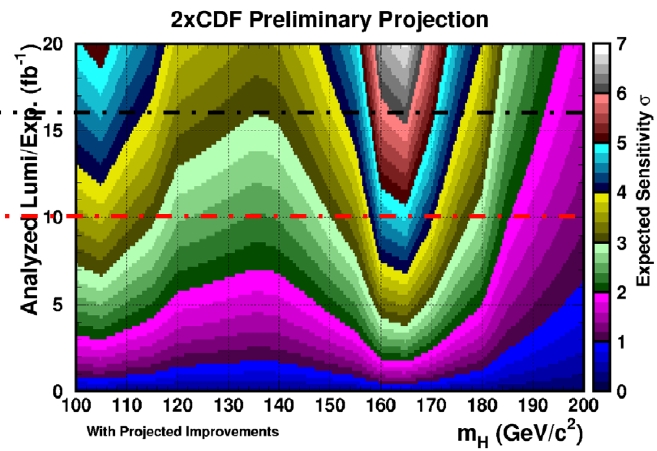The truth of the matter is that there were two possible talks to give here in Split; the other one was on Higgs boson physics at the Tevatron. And it was that one which I preferred to be assigned... But of course, I am still happy of being here representing the two experiments; it is actually mildly surprising that I was actually allowed to do it, if you think that some of the collaborators of one of the two notoriously do not like me that much, going as far as to quote me as "not a trustable source of information", or "the National Enquirer" of particle physics, due to their dislike of the outreach activities going on in this site (or specific criticism of their results ?). Well, I bear no grudge, so let me leave the topic here.
One of the slides of the talk I would have liked to give here in Split, at the "LHC Days", is one which produces predictions for the sensitivity to the Higgs boson that CDF and DZERO will reach if they are allowed to run for three more years. Despite the additional possibilities that an approximate doubling of the integrated luminosity would provide in new physics searches and other highly intersting physics measurements, it is on that information -the Higgs reach- which is based the request to extend the operation of the Tevatron beyond what the laboratory has planned.
The request to run through 2013 is well timed: on one hand, the Tevatron has recently produced a successful exclusion of Higgs boson masses in the 160-GeV region, which can hardly be argued against as somebody tried to do last year. On the other hand, during the last fiscal year (2010, ending October 1st) the Tevatron exceeded its rosiest expectations for integrated luminosity delivered to the experiments, as shown in the graph below.

The "rosiest expectations" are shown by the thin red line in the graph. So with 2.5 inverse femtobarns per year added to the already bagged 9.3, it is reasonable to expect that by the end of 2013 about 16 inverse femtobarns of collisions -over a quadrillion proton-antiproton collisions!- will be available to CDF and DZERO. So what could the two experiments obtain in the quest for the Higgs boson ? It is shown in the figure below, which to me resembles a picture by Jawlenski.

In the figure you can see the number of standard deviations expected from a Higgs signal by the experiments as a function of the unknown Higgs mass (on the horizontal axis), and as a function of integrated luminosity (on the vertical axis). Significance is color-coded such that a 3-sigma excess is at the border between light green and brownish green, and a 5-sigma excess is at the border between blue and red. 10/fb and 16/fb levels are shown with black and red hatched lines, respectively.
It does not take an experimental physicist to figure out that with 16/fb the Tevatron forecasts to obtain an over 3-sigma signal of Higgs production whatever the Higgs mass is. The difference with the option of stopping data-taking in 2011 (which means about 10/fb per experiment) is that in the most interesting region (between 115 and 150 GeV) the likely "evidence" will only reach 2.4 standard deviations. Not a huge difference, admittedly.
Two small print notes: the plot shows the situation forecast "with projected improvements" in the analysis methods. These are credible, but not certain to be achievable. And the other point is that this plot assumes that CDF and DZERO combine their sensitivity, but the CDF sensitivity is taken as a benchmark. Now, we know that CDF is presently doing sizably better than DZERO in the Higgs-boson search these days, especially at low mass; additional effort on DZERO part will probably fill this gap, but it is nonetheless another point which subtracts a little credibility to the figure.
A further caveat for quick users of the information provided in the figure above: you should realize that what is presented is the predicted median of the number of standard deviations, which -for a given Higgs mass and luminosity- is a wide distribution, due to random fluctuations in backgrounds and signal. What this means is that the actual results might differ significantly from those displayed. When you base your "3-sigma evidence" on a signal of a dozen events or so smeared in several search channels, over backgrounds which in the most sensitive region are of the same order of magnitude, you are unavoidably sensitive to fluctuations.
Still, 3-sigma are, if computed properly, 3-sigma: a 0.3% probability that the signal you observe is a fluctuation. Of course such an evidence would not advance our knowledge of fundamental interactions groundbreakingly; however, reaching the goal of indicating to the LHC experiments where to look for the Higgs boson would unquestionably be the best way to close the Tevatron collider program.
Whether the above is a sufficient case for an extension of the collider run or not, I am not capable of saying. My opinion, however, is that we should look at particle physics as a global endeavour, and not as a challenge between laboratories. I want to know what causes electroweak symmetry breaking and how, and I am not so excited by the competition!




Comments